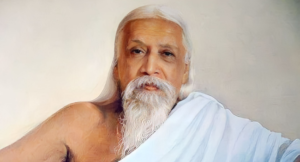“Meditation means withdrawing the mind from all distractions and making it abide in the Self (the Atman, the soul, the pure consciousness).”
– Sri Aurobindo
Those of us who reside in India, especially in the big cities, live amidst constant noise. There are cars honking, loudspeakers blaring and dogs barking.
So in such noisy surroundings, it is not surprising that many of us find it impossible to meditate. How can one focus their mind with so much disturbance outside?

– The Mother, Sri Aurobindo Ashram
Now a wonderful solution to this dilemma, has been offered by the Holy Mother (Sri Aurobindo Ashram). The incident containing her profound teaching has been preserved by her ardent devotee and disciple, Champaklal Maharaj, in the book – Champaklal Speaks. Here is the story:
Once Mother asked Champaklal Maharaj to cover an open well. She was concerned that cats playing around the well, might fall into it. So Mother gave detailed instructions to Maharaj, on how to construct a lid for the well, out of a wooden box. Maharaj took the box to the guest house where he was residing, and began hammering away at the lid in the courtyard. This is what happened next:
“Naturally it made a big noise and one sadhak (spiritual aspirant) came out of his room and began to grumble that it was disturbing his meditation. In those days sadhaks were very fond of meditating.
When I informed Mother about it, she said: “Sri Aurobindo and I are not disturbed by noise. If one cannot meditate amidst noise it only proves that one is not truly meditating. One must be able to meditate even on the battlefield. We are not particular. If they are disturbed there, you may work here; disturb here.”
When the poor sadhak who had complained came to know of this, he was very sorry and asked to be pardoned. Of course I had not said anything to him. Thus I did not have to change the place of work and when the cover was completed, Mother was very happy both for the completion of the work and the change in the sadhak.”
– Champaklal Maharaj, in the book Champaklal Speaks.
Meditation as the great Acharya, Shriram Sharma has explained in his book Jap, Tap, Dhyan is nothing but a training of the mind to withdraw from all external and internal distractions and flow in one uninterrupted stream towards a specific object of devotion.
Here by external and internal distractions are meant all those disturbances which pull the mind’s attention away from resting on the Self, (the Atman, the soul, the pure infinite consciousness) and instead the mind remains preoccupied with either:
-
Things belonging to the outer world, such as noise, material possessions, enjoyment of food, property, wealth, fame, sex etc., or,
-
Things belonging to the inner world such as intruding thoughts, feelings of greed, jealously, anger, fear, anxiety, etc.
A steady unbroken concentration is absolutely essential in meditation, and the mind must be prevented from dwelling upon external and internal distractions. Only when the attention of such a concentrated mind is focused upon realizing the true state of being – the infinite Sat-Chit-Ananda consciousness, does meditation yield results.
Now the true mark of a deep meditation with steady concentration, is the ability to remain undisturbed by the presence of noise and other distractions. Therefore whenever it is noisy outside, instead of getting irritated and anxious, our sincere attempt must be to think of this environment as a training ground, and repeatedly practice making our meditation immune to external disturbances.
Repetition and practice as with everything else in life, are key to becoming successful at meditation:
“Mind has a natural tendency to roam randomly. Meditation is the repetitive process of refocussing the thoughts again and again on the object of meditation. This is a time consuming process. Full concentration (such as at the moment of Samadhi) is achieved only after prolonged practice, and so one should not be in a haste to acquire Samadhi.”
– Shriram Sharma Acharya in the book Jap, Tap, Dhyan.
Now one additional point to note here, is that mere concentration alone, is not sufficient to attain Samadhi.
As Shriram Sharma Acharya has explained, what is further required is a complete absorption, or realization of oneness and unity with the Ishta (i.e. the object of our meditation).
Because the Ishta in meditation is nothing but a symbolic representation of God – the Divine Consciousness. Thus whatever symbol we utilize in our meditation, be it the rising sun, the boundless open sky, an image such as that of Lord Krishna or the Divine Mother Gayatri – all these are symbolic representations of God.
And the goal of any meditation is to concentrate upon these symbols and along with this concentration, try to develop a sense of closeness, a sense of unity and identification with the attributes of the Supreme Being behind the symbols.
When this concentration and identification are complete Samadhi is the result. Then one no longer feels like a mere individual living on earth, separated from the Divine, but the person, at all times, experiences permanent unity and identification with the Divine – the Omnipresent Reality – the infinite Sat-Chit-Ananda consciousness.
“In course of meditation, one remembers the Creator as well as contemplates on one’s true identity as part of the Supreme Being. While meditating, the devotee is reminded of the oneness of the individual self and the Omnipresent Supreme Self.”
– Shriram Sharma Acharya








